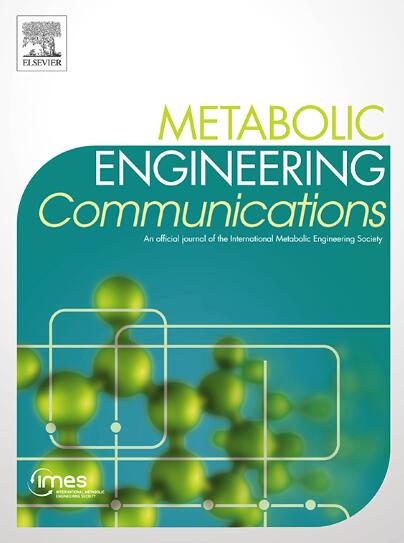体内酶选择系统的代谢生长偶联策略
IF 4.1
Q2 BIOTECHNOLOGY & APPLIED MICROBIOLOGY
引用次数: 0
摘要
全细胞生物催化有助于从可持续的原料(如塑料废物、二氧化碳、木质纤维素或植物性糖源)中生产广泛的工业和制药相关分子。在应用生物催化剂中识别和使用高效酶是建立经济可行的生产工艺的关键。在以生长为选择标准的适应性实验室进化实验中,酶的催化活性与微生物代谢活性紧密耦合,促进了有利酶变体的产生和选择。在这里,我们提出了一种计算工作流程,通过共享一类酶来设计具有严重的生长限制代谢瓶颈的菌株。由此产生的底盘细胞,被称为酶选择系统(ESS),是一个生长偶联的平台,从各自的酶类的任何酶,从而提供交叉途径应用于酶工程的目的。通过应用基于约束的建模工作流,为大肠杆菌和广泛的与生物技术相关的生产途径建立了一个可公开访问的数据库,其中包含25,505种潜在的和实验可处理的ESS设计。对生成的设计数据库进行基于模型的分析,揭示了一个通用的设计原则,即目标酶的活性与整体微生物代谢活性有关,而不仅仅是一种生物质前体的合成。由此可见,靶酶与代谢活性之间的耦合越强,ESS的最大生长速率越低,因此生存力越低。因此,仅具有次优耦合强度的增长耦合策略,如ESS设计数据库中所包含的,可能对ESS的实际应用感兴趣,以避免过度限制的增长缺陷。总之,可通过https://biosustain.github.io/ESS-Designs/访问的计算设计数据库及其分析为产生有价值的体内ESSs提供了基础,用于酶优化目的和一系列生物技术应用。本文章由计算机程序翻译,如有差异,请以英文原文为准。

Metabolic growth-coupling strategies for in vivo enzyme selection systems
Whole-cell biocatalysis facilitates the production of a wide range of industrially and pharmaceutically relevant molecules from sustainable feedstocks such as plastic wastes, carbon dioxide, lignocellulose, or plant-based sugar sources. The identification and use of efficient enzymes in the applied biocatalyst is key to establishing economically feasible production processes. The generation and selection of favorable enzyme variants in adaptive laboratory evolution experiments using growth as a selection criterion is facilitated by tightly coupling enzyme catalytic activity to microbial metabolic activity. Here, we present a computational workflow to design strains that have a severe, growth-limiting metabolic chokepoint through a shared class of enzymes. The resulting chassis cell, termed enzyme selection system (ESS), is a platform for growth-coupling any enzyme from the respective enzyme class, thus offering cross-pathway application for enzyme engineering purposes. By applying the constraint-based modeling workflow, a publicly accessible database of 25,505 potential and experimentally tractable ESS designs was built for Escherichia coli and a broad range of production pathways with biotechnological relevance. A model-based analysis of the generated design database reveals a general design principle that the target enzyme activity is linked to overall microbial metabolic activity, not just the synthesis of one biomass precursor. It can be observed that the stronger the predicted coupling between target enzyme and metabolic activity, the lower the maximum growth rate and therefore the viability of an ESS. Consequently, growth-coupling strategies with only suboptimal coupling strengths, as are included in the ESS design database, may be of interest for practical applications of ESSs in order to circumvent overly restrictive growth defects. In summary, the computed design database, which is accessible via https://biosustain.github.io/ESS-Designs/, and its analysis provide a foundation for the generation of valuable in vivo ESSs for enzyme optimization purposes and a range of biotechnological applications in general.
求助全文
通过发布文献求助,成功后即可免费获取论文全文。
去求助
来源期刊

Metabolic Engineering Communications
Medicine-Endocrinology, Diabetes and Metabolism
CiteScore
13.30
自引率
1.90%
发文量
22
审稿时长
18 weeks
期刊介绍:
Metabolic Engineering Communications, a companion title to Metabolic Engineering (MBE), is devoted to publishing original research in the areas of metabolic engineering, synthetic biology, computational biology and systems biology for problems related to metabolism and the engineering of metabolism for the production of fuels, chemicals, and pharmaceuticals. The journal will carry articles on the design, construction, and analysis of biological systems ranging from pathway components to biological complexes and genomes (including genomic, analytical and bioinformatics methods) in suitable host cells to allow them to produce novel compounds of industrial and medical interest. Demonstrations of regulatory designs and synthetic circuits that alter the performance of biochemical pathways and cellular processes will also be presented. Metabolic Engineering Communications complements MBE by publishing articles that are either shorter than those published in the full journal, or which describe key elements of larger metabolic engineering efforts.
 求助内容:
求助内容: 应助结果提醒方式:
应助结果提醒方式:


